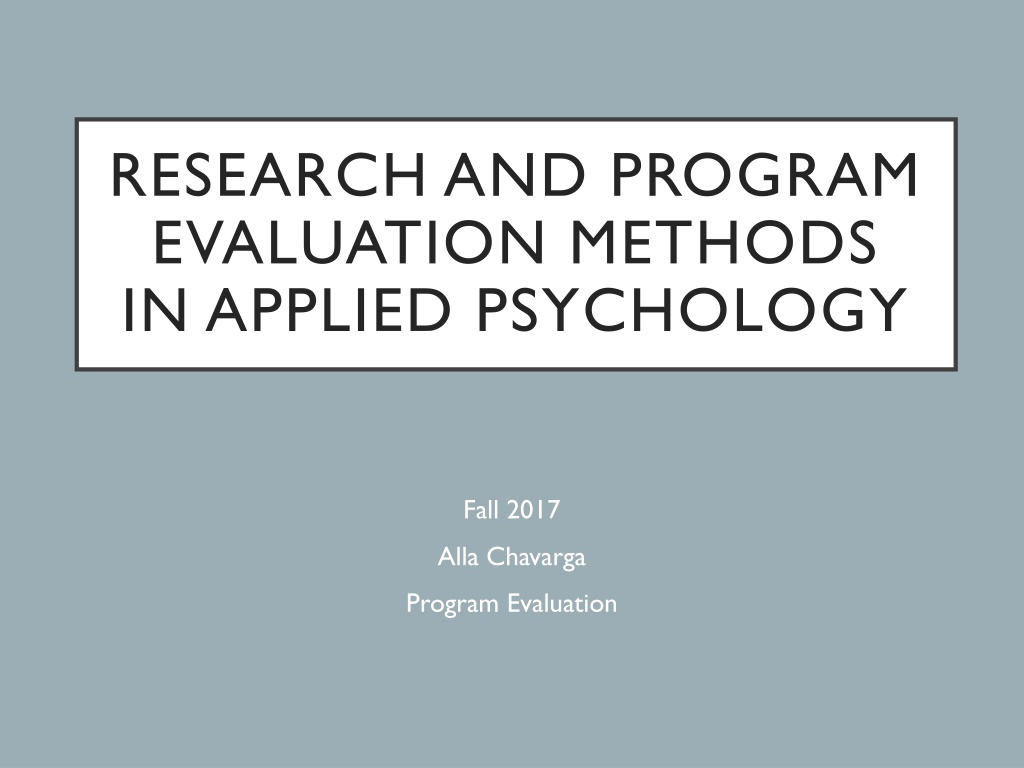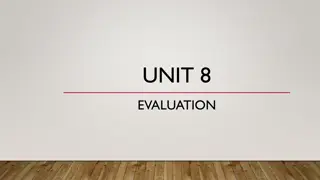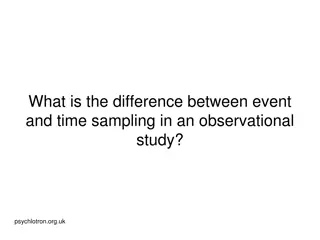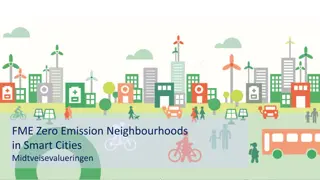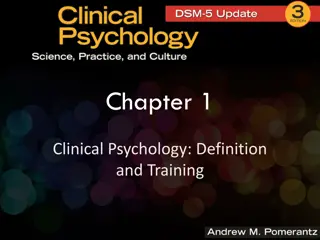Program Evaluation Methods in Applied Psychology
Program evaluation in applied psychology involves investigating the effectiveness and impact of social programs or interventions. Its goal is to assess whether the costs of a program are justified, not to produce generalizable knowledge. Evaluation seeks to reduce uncertainty for decision-makers and stakeholders. It is different from basic research as it focuses on improving programs rather than proving concepts. Surveillance tracks diseases, monitoring tracks program outcomes, and evaluation seeks to understand the reasons behind changes. A program consists of related activities aimed at achieving specific objectives. Examples of programs include Stop and Frisk in New York, Health Care Reform in the US, Team-Based Learning courses at Brooklyn College, and Alcoholics Anonymous' 12-step program.
Download Presentation

Please find below an Image/Link to download the presentation.
The content on the website is provided AS IS for your information and personal use only. It may not be sold, licensed, or shared on other websites without obtaining consent from the author. Download presentation by click this link. If you encounter any issues during the download, it is possible that the publisher has removed the file from their server.
E N D
Presentation Transcript
RESEARCH AND PROGRAM EVALUATION METHODS IN APPLIED PSYCHOLOGY Fall 2017 Alla Chavarga Program Evaluation
WHY DO WE NEED PROGRAM EVALUATION?
WHAT IS PROGRAM EVALUATION? Alternative term: Evaluation Research Definition: Investigations designed to test the effectiveness or impact of a social program or intervention. (Vogt, 1999, p. 100) Evaluation can be viewed as a structured process that creates and synthesizes information intended to reduce the level of uncertainty for decision makers and stakeholders about a given program or policy. (Rossi, Freeman, & Lipsey, 2003) Systematic investigation of effectiveness of intervention programs
GOALS OF PROGRAM EVALUATION Type of applied research (as opposed to Basic Research) Goal: Evaluate effectiveness, mostly to assess whether costs of intervention/program are justified Not a goal: Producing generalizable knowledge or testing theories! But: Methodology used is the same/similar as in basic research
Research seeks to prove (provide support for), evaluation seeks to improve M.Q. Patton
SURVEILLANCE & MONITORING VS. PROGRAM EVALUATION Surveillance - tracks disease or risk behaviors Monitoring - tracks changes in program outcomes over time Evaluation - seeks to understand specifically why these changes occur
WHAT IS A PROGRAM? a group of related activities that is intended to achieve one or several related objectives . (McDavid & Hawthorn, 2006, p. 15) A program is not a single intervention (think back to last class) Means-ends relationships: (contrast with cause-effect) Resources are consumed or converted into activities Activities are intended as means to achieve objectives Varying in scale Varying in cost
EXAMPLES OF PROGRAMS New York: Stop and Frisk or Broken Windows Theory US: Health Care Reform Brooklyn College: Team Based Learning courses Alcoholics Anonymous: 12-Step program Richmond, California: Reducing homicide rates in city http://www.cnn.com/2016/05/19/health/cash-for-criminals- richmond-california/index.html
WHY EVALUATE PROGRAMS? To gain insight about a program and its operations to see where we are going and where we are coming from, and to find out what works and what doesn t To improve practice to modify or adapt practice to enhance the success of activities To assess effects to see how well we are meeting objectives and goals, how the program benefits the community, and to provide evidence of effectiveness To build capacity - increase funding, enhance skills, strengthen accountability
PROGRAM EVALUATION AND PERFORMANCE MEASUREMENT Used by managers, not evaluators Challenges: find performance measures that are valid Albert Einstein: Everything that can be counted does not necessarily count; everything that counts cannot necessarily be counted.
EXAMPLES OF PROGRAM EVALUATION (PE) Assessing literacy Occupational training programs Public health initiatives to reduce mortality Western Electric: Hawthorne studies (productivity) Evaluate propaganda techniques (election results? Surveys?) Family planning programs (rate of unwanted pregnancies? Abortions?) (Rossi, Lipsey, & Freeman, 2003)
KEY QUESTIONS FOR PROGRAM EVALUATION Did the program achieve its intended objectives? Did the program achieve the observed outcomes? Are the observed outcomes consistent with the intended outcomes? McDavid & Hawthorn, 2006
KEY EVALUATION QUESTIONS Was the program efficient? Technically efficient: cost per unit of work done Was the program cost-effective? Cost per unit of outcome achieved Was the program appropriate? What is the rationale for the program? Still relevant? Was the program adequate? Large enough to do the job? How well (if at all) was the program implemented? McDavid & Hawthorn, 2006
PROGRAM LOGIC MODELS Resources required to run program Cost $$ Monetize $$
PROGRAM INPUTS-OUTPUTS Compare program costs to outputs (technical efficiency) Compare program costs to outcomes (cost-effectiveness) Compare costs to monetized values of outcomes (cost- benefit analysis)
EXAMPLE E.g.: Problem: residents are leaving neighborhood because it is deteriorating Program: Offer property tax breaks to home owners if they upgrade physical appearance of their homes Outcomes: Short term: number of houses rehabilitated Long-term: people don t leave the neighborhood any more
WHEN TO CONDUCT EVALUATION? Planning a NEW program Assessing a DEVELOPING program Assessing a STABLE, MATURE program Assessing a program after it has ENDED Conception Completion The stage of program development influences the reason for program evaluation, and the type of information gathered.
TYPES OF PROGRAM EVALUATION Monitoring programs formative evaluation Evaluating program while in progress Implemented as planned? Program audit Pilot study Evaluating outcomes summative evaluation Program effectiveness Use of quasi-experimental designs Failure to reject H0 can be a useful outcome (Breast cancer example) New programs have to prove themselves
TYPES OF PROGRAM EVALUATION Ex-post evaluations: Program has been in place for a time Assess program up to present day, offer advice for future Ex-ante evaluations (less frequent): Before implementation Pilot programs Baseline assessment possible
IMPACT EVALUATION Impact: more than just outcomes Long-term outcomes Deeper outcomes Which other factors may have influenced results? Unintended outcomes? Accidental outcomes?
RESEARCH DESIGNS FOR PROGRAM EVALUATION Standard experimental designs Two groups comparison Two by two factorial design Pre-test post-test design Post-test only design Solomon Four Group Design
TWO BY TWO FACTORIAL DESIGN (2 X 2) Used for more than one IV (independent variable) Can use more than two independent variables Asses Main Effects AND Interaction Effects Traditional Classroom Team-Based Learning Classroom 65 Mathematics Course 65 Psychology Course 75 90
SOLOMON FOUR GROUP DESIGN Group1 Pre Program Post Group2 Pre Post Group3 Program Post Group4 Post
ASSESSING NEEDS FOR A PROGRAM Become familiar with political/organizational context Identify the users and uses of needs assessment Identify the target population(s) who will be or are currently being served Inventory existing services available to target population, identify potential gaps Identify needs, using complementary strategies for collecting and recording data
PROGRAM EVALUATION Needs analysis Resources Census data Surveys of potential users Key informants, focus groups, community forums Research example 33 Healthy behaviors in the workplace (DuPont) Examined employee health data Surveyed existing company programs Surveyed employee knowledge of healthy behavior
PROGRAM EVALUATION Applied research that attempts to assess the effectiveness and value of policies Reforms as experiments Connecticut speeding study Regression plus some degree of effectiveness with control states comparison
PROGRAM EVALUATION A note on qualitative analysis Common in program analysis Needs analysis interview info Formative and summative evaluations observations e.g., energy conservation in Bath, England included both quantitative (energy usage) and qualitative (focus group interviews) information
PROGRAM EVALUATION Ethics and program evaluation Consent issues (coercion, fear of loss of services, often vulnerable populations receiving social services) Confidentiality issues anonymity not compatible with evaluation measures, longitudinal data gathering, reports to stakeholders, etc Perceived injustice Participant crosstalk control group perceives themselves at a disadvantage
CREATING A PROGRAM 1. Need for the program/service 2. Design of the program/service 3. Program/service implementation and service delivery 4. Program/service outcome; program impact evaluation 5. Program/service efficiency
THE FOUR STANDARDS Utility: Who needs the information and what information do they need? (stakeholders!) Typically this kind of research is not experimenter -motivated Feasibility: How much money, time, and effort can we put into this? Propriety: What steps need to be taken for the evaluation to be ethical? Accuracy: What design will lead to accurate information?
